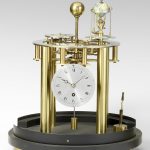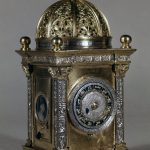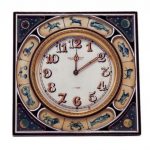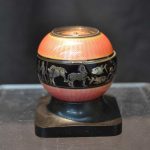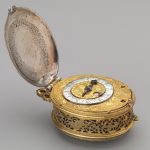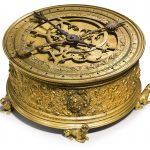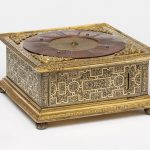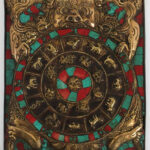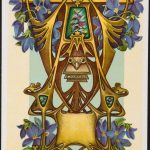Astrological Clocks. By the 1550s it was fashionable for wealthy gentlemen to have a sound understanding of all branches of learning, from art and literature to mathematics and the natural sciences. Clocks were housed alongside automatons and scientific instruments such as astrolabes and sundials in Scientifica, collections celebrating the human ability to control nature.
Below are some examples of these clocks as well as other clocks with an astronomical / astrological theme.
A perpetual calendar timepiece with orrery Roland Jarvis Raised on four plain brass columns, mounted on a circular, black painted base, beneath a glass dome, the columns supporting the silvered calendar dial with concentric month, day and 5 day tracks, read via a hand fitted to the rotating central section with Heliocentric rotating Earth with ball moon over moonphase, age of moon and 360 degree dial, opposite a second dial with astrological symbols, subsidiary bisextile dial and year aperture (expressed by the last two numerals of the year). Timepiece and base 38cm (15in)
Sold for £ 3,500 inc. premium at Bonhams in 2017
Spring driven table clock with hour striking, moon and annual calendar indicationsCase and movement frameThe clock has a posted frame construction with a side-by-side movement layout, the trains at right angles to the dial. The posts form external pilasters at the corners of the clock and are integral with brass top and bottom plates. Removable iron train bars are wedged in the top plate and have integral pins locating in holes in bottom plate. A bell-stand is pinned to the top plate. Four side panels fit between the pilasters, sliding-in from the bottom. The frame sits in the recess of a decorated plinth and is secured from underneath by a single winged screw. The top of the frame sits in the recess of a decorated cornice, of similar construction to the plinth. The top is secured by a pierced dome, which is placed over the bell stand and secured by a nut in the form of a lion.The gilded brass posts are in the form of square Corinthian columns. The sides of the pilasters have applied silver plaques, embossed with a foliate design. The panels which form the sides of the case are of gilded brass. The front panel bears an applied silver chapter ring marked “I” to “XXIIII” for 24 hours. The side and rear panels each have a small door, providing access to the movement. The side doors have holes to admit the winding squares. Each of the three doors has a niello medallion applied. The niello on the proper right depicts the profile bust of a bearded male and is inscribed “AVGVSTINVS BARBARIGVS DVX VE” [Augustino Barbarigo, doge of Venice]. The niello on proper left depicts the 3/4 bust of a male and is inscribed “LEONARDVS LOREDANVS DVX VE” [Leonardo Loredano, also doge of Venice]. The niello on rear panel depicts a winged lion of St. Mark bearing an open book with text “PAX TIBI MA EV MEUS” [an abbreviated form of the motto of Venice].The plinth and cornice are of gilded brass with applied silver plaques, embossed with a palmette design. The plinth has bun feet in gilded brass at each corner. The cornice is surmounted by spheroidal finials in gilded brass at each corner. The gilded brass dome is formed of eight panels, pierced and chased with an acanthus leaf design. The circumference of the bottom of the dome is engraved and infilled with wax; “IO PAV E IO CAROL FIL REGIEN OP MID”. The gilded brass lion which surmounts the dome bears an open book with partly legible text that may read; “F##S TIBI MARI EITA”.
DialThe dial comprises a disc assembly with epicyclic gearing driving moving bands. The assembly rotates within a silver hour chapter ring that is fixed to the front panel of the clock. The following describes the bands from the outside in;1) Silver chapter ring (fixed); 1.1) Hours. The hours “I” to “XXIIII” are engraved and filled with black wax. The hour “XVIII” is at the top of the chapter ring, indicating the start to the day is at 18:00 [suggesting the use of the Italian/Bohemian hour system]. The hour is indicated by the largest flare of the sun effigy, which is born on the dial assembly and rotates once in 24 hours. 2) Silver outer band of dial assembly (driven by epicyclic gearing that is born within the assembly); 2.1) Annual calendar. The months are provided in abbreviated English; “DECE”, “NOVE”, “OCTO”, “SEPT”, “AVG”, “IVLI”, “IVNI”, “MAI”, “APRI”, “MAR”, “FEBR” and “IANV”, engraved and filled with black wax. Each month has six subdivisions, i.e. approx. 5 days. The approximate date is indicated by the largest flare of the sun effigy. 2.2) 12 signs of the zodiac, raised and gilded on a blue enamel ground. The position of the Sun in the zodiac is indicated by largest flare the sun effigy.3) Gilt brass sun ring (revolves once in 24 hours with main dial assembly). 3.1) Sun effigy. The largest flare is the “hand” of the clock. 3.2) Glyphs for the major astrological aspects; asterisk [sextile], square [square], triangle [trine] and linked circles [opposition].4) Silver inner disc (driven by epicyclic gearing that is born within the dial assembly) 4.1) Age of the moon (days). The days (1-29.5) are engraved and in-filled with black wax. 4.2) Phase of the moon (pictorial). The phase of the moon is indicated in the aperture of the disc. The disc is engraved to suggest stars in the night sky. Behind the disc, the moon phase curve is engraved on a silver plate, with a ground of blue enamel which is damaged and missing in parts.
Reference: © The Trustees of the British Museum
A GERMAN GILT-BRASS STRIKING AND ASTRONOMICAL TABLE CLOCK AUGSBURG, CIRCA 1560-70 The drum case with strapwork and pierced borders, the latched base on pomegranate feet; the MASTER DIAL showing: mean time indicated by the steel hour hand to twelve hours and touch pieces to the outer ring, solar time indicated by hand with stylised sun and engraved ‘SOL‘ to twenty-four hour ring, Nurnberg hours indicated by a pair of hands and engraved ‘OC NOR’ (for occasus Norimbergia – the end of the Nurnberg day) and ‘OR DIES’ (for ortus dies or ora dies), hours of the moon indicated by a pair of hands engraved ‘OCCIDENS’ (for West) and ‘ORIENS’ (for East), Zodiac band, date band and central astrology chart with moon-orb to show phases; the UNDERSIDE COVER showing: a ‘de Rois type’ astrolabe dial and smaller dial stippled as ‘light’ and ‘dark’ and engraved ‘OC’, ‘OR’, ‘NOR’ and ‘DIS’, stamped with Augsburg pinecone flanked by an unidentified makers mark struck twice; the UNDER-DIAL with: Nurnberg hour setting dials for both sun and moon each furnishing motion to the pair of hands on the Master dial, intermediate wheels covered by engraved panels to the centre, two pointers and squares for shutting off the striking; the posted steel framed MOVEMENT with chain fusee to the going train, verge escapement, brass balance wheel with balance spring, standing barrel to the strike train, fly and countwheel strike to bell, standing barrel to the quarters train, fly and countwheel to bell 3 ¾ in. (9.5 cm.) high, 6 ¾ in. (17 cm.) diameter
Sold for USD 725,000 at Christies in 2015
French Enameled Silver Astrological Desk Clock Retailed by Mappin & Webb Of square form, in black and white, the circular dial with Arabic numerals, decorated with the twelve signs of the zodiac. Height 4 5/8 inches, width 4 1/2 inches.
Clock case appears to be in generally good condition; there are enamel losses to numerals on the dial; small areas of paint loss to the zodiac figures, most notably to Sagittarius, part of one of the scales (Libra) and there appears to be a small bit of paint splatter to the two women representing Gemini; wording “Eight Days” (?) is worn away on dial; clock has a winding mechanism on the back.
Sold for $1,500 (includes buyer’s premium) at Doyle New York in 2009
Guilloche clock with astrological signs
Sold for $550 at Echoes Antiques & Auction Gallery, Inc. in 2018
Clock-watch with alarm and calendar Maker: Watchmaker: Nicolas Forfaict (French, Paris, ca. 1580–1615) Date:ca. 1600–1610 Culture: French, Paris Medium: Movement: gilded breass and steel, partly blued; case and dial: brass, silvered brass, silver; hand: steel
The case and dial of this watch are engraved with designs of inhabited foliage and grotesque ornament, the latter having its inspiration in the engravings of the French artist Jacques Androuet Du Cerceau (ca. 1512–ca. 1585). The side, or band, of the case is pierced to permit the sound to be heard when the watch strikes the hour (1–12) on the bell attached to the inside of the bottom of the case. A single hand indicates the hours and the half hours marked in the silver chapter ring applied to the dial. A small hand attached to a disk that revolves inside the chapter ring indicates the moon’s age in its monthly cycle, and an aperture in the disk displays the phases of the moon. Further, the length of time of moonlight after sundown can be read at the edge of the disk, and in its center there is an aspectarium showing the changes in the angular distance between the sun and the moon in the zodiac, information useful for astrological purposes.
Reference: The Metropolitan Museum of Art
Table clock German (Augsburg) about 1625–50
Astronomical quarter striking astrolabic and zodiacal table clock. Gilt with astronomical & astrological dials on four sides, of silver with blue, orange & green enamel. Two bells in top. Frame engraved with scrolls & fruit, medallions on two sides of base; vases on two ends under dials, and landscapes on front and back. Musical mechanism added above gallery on top.
This elaborate clock in the form of a building is as much a precious work of art as a complicated scientific instrument. Dials on this side record the time of day and night, days of the week, months, seasons, signs of the zodiac, and the date according to an ancient Roman calendar. The other side measures astronomical time and the position of the sun and moon at various times of day. Additional dials allow one to set an alarm and regulate the striking of hours and quarter hours. Such complex mechanisms were awe-inspiring wonders of their day. The ability to measure the known universe with man-made machines was a potent demonstration of its owner’s knowledge, power, and wealth.
South German, circa 1575 RENAISSANCE ASTRONOMICAL TABLE CLOCK 8 inch dial numbered I-XII twice and enclosing an astrolabe with named stars and zodiac calendar, sun/moon hand, the iron movement with square pillars, chain fusees to both going and striking trains, verge escapement with steel foliot, bell striking with count wheel mounted on the backplate, the drum case decorated in relief with strapwork scrolls, fruit, birds and cartouches centered by masks, interspersed with allegorical figures and terms, resting on five lion-form feet, baseplate inverted and engraved on interior, extensive later alterations and replacements. gilt bronze height 3 7/8 in.; 9.8 cm., diameter of dial 8 in.; 20.2 cm.
Sold for 137,500 USD at Sothebys in 2016
Table clock with alarm in square brass case on four bun feet, whose underside has sundials and calendars. The brass clock dial with applied copper chapter ring on the top surface is a later alteration from around 1700. The flat iron sides are lightly engraved and damascened with strapwork. The movement of the clock is mounted between two iron plates 175mm square finely engraved with strapwork on both surfaces. The movement has been extensively altered but still contains: the going train with engraved brass barrel, fusee and chain; the striking train with engraved brass barrel and ‘nag’s head’ release; the alarm train with plain brass resting barrel and single-end bell hammer whose tail engages with a ratchet-toothed wheel. Inside there are 3 brass dials no longer with any mechanisms attached: a ring with the zodiac signs; a ring marked 1 to 12; a disc numbered 1 to 7 with weekday symbols marked ‘DIES PLANETARVM’. The removable bottom cover is of brass engraved with intertwined foliage and has four large engraved circular dials and one small one: Top left: ‘CIRCLVS EPACTA’ with an inner ring of years from 1567 to 1585 and with an outer ring giving the epact (the number of days the solar year exceeds the lunar year of 12 months) and a hand-set rotating dial marked ‘EPACTA’ Top right: A horizontal sundial showing hours a.m. and p.m. and the Italian hours. A compass box, now with needle missing, is mounted over part of this dial. The box has a removable engraved lid. Bottom left: a series of concentric rings showing the Dominical letters (denoting the dates of Sundays) including Advent Sunday for a 28-year solar cycle for the years 1560 to 1587 marked ‘CIRCVLS SOLARIUS’, and with a hand-set rotating arm marked ‘ADVENTVS DOM’. Bottom right: Rings giving the ‘golden numbers’ (used to calculate the date of Easter) and corresponding dates for Easter Day for a cycle of 19 years from 1558 to 1576 marked ‘AVREVS NVMERVS’ and with a hand-set rotating arm marked ‘PASCHA’. Centre: A small ring for the cycle of the Indiction, a measurable period of time on the ecclesiastical calendar, with 1558 opposite year 1, and with a hand-set rotating arm marked ‘INDICTIO’
Reference: © Victoria and Albert Museum
